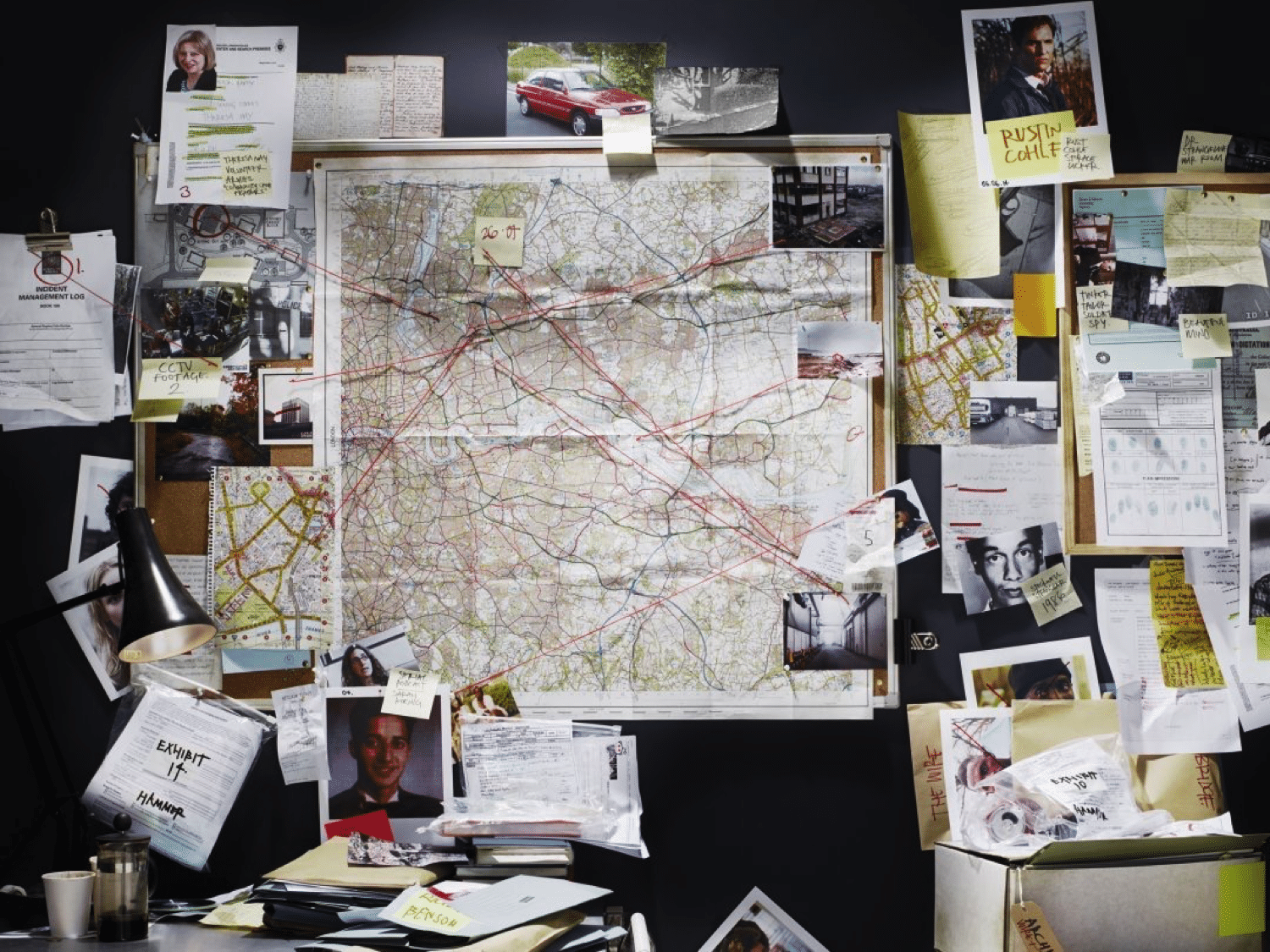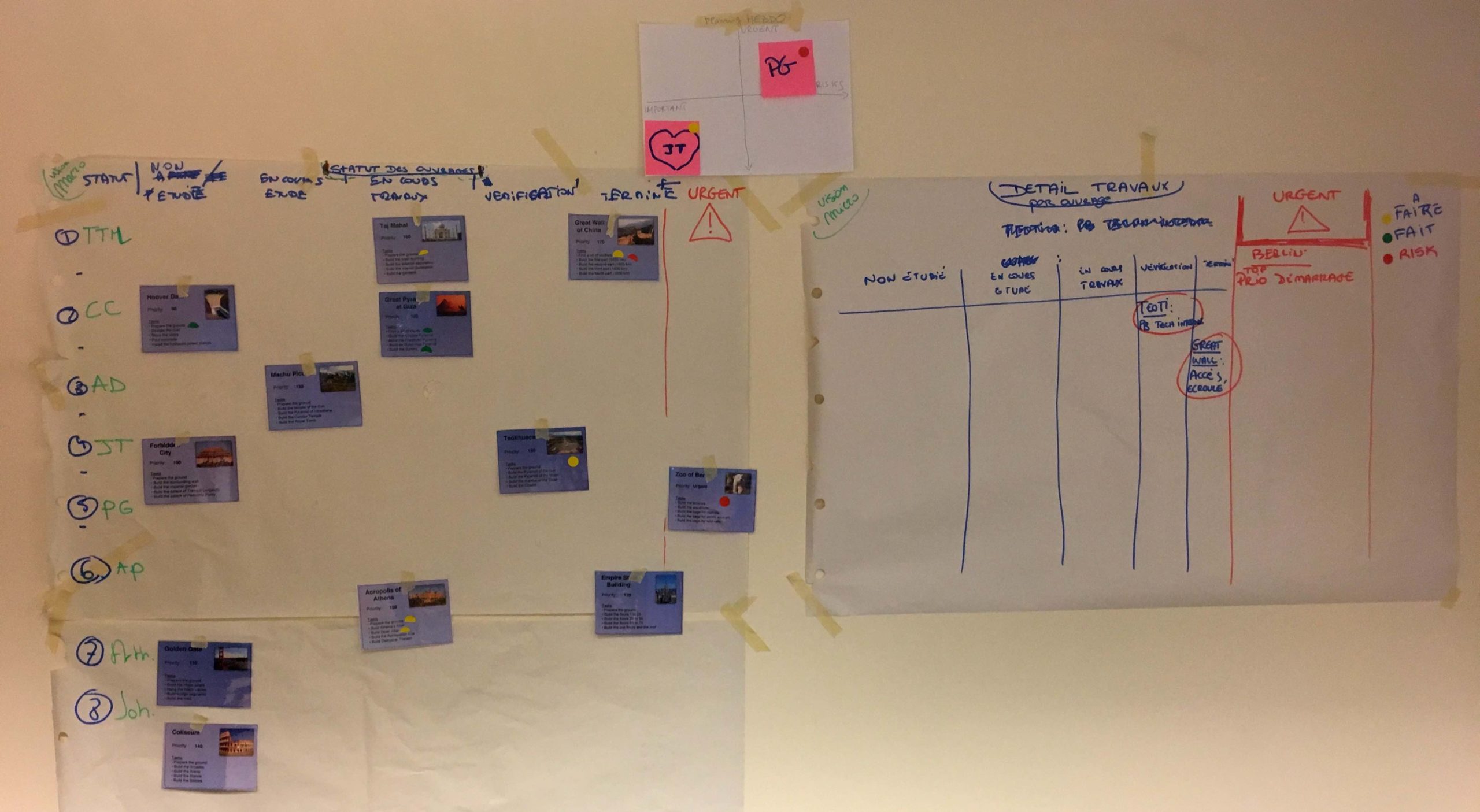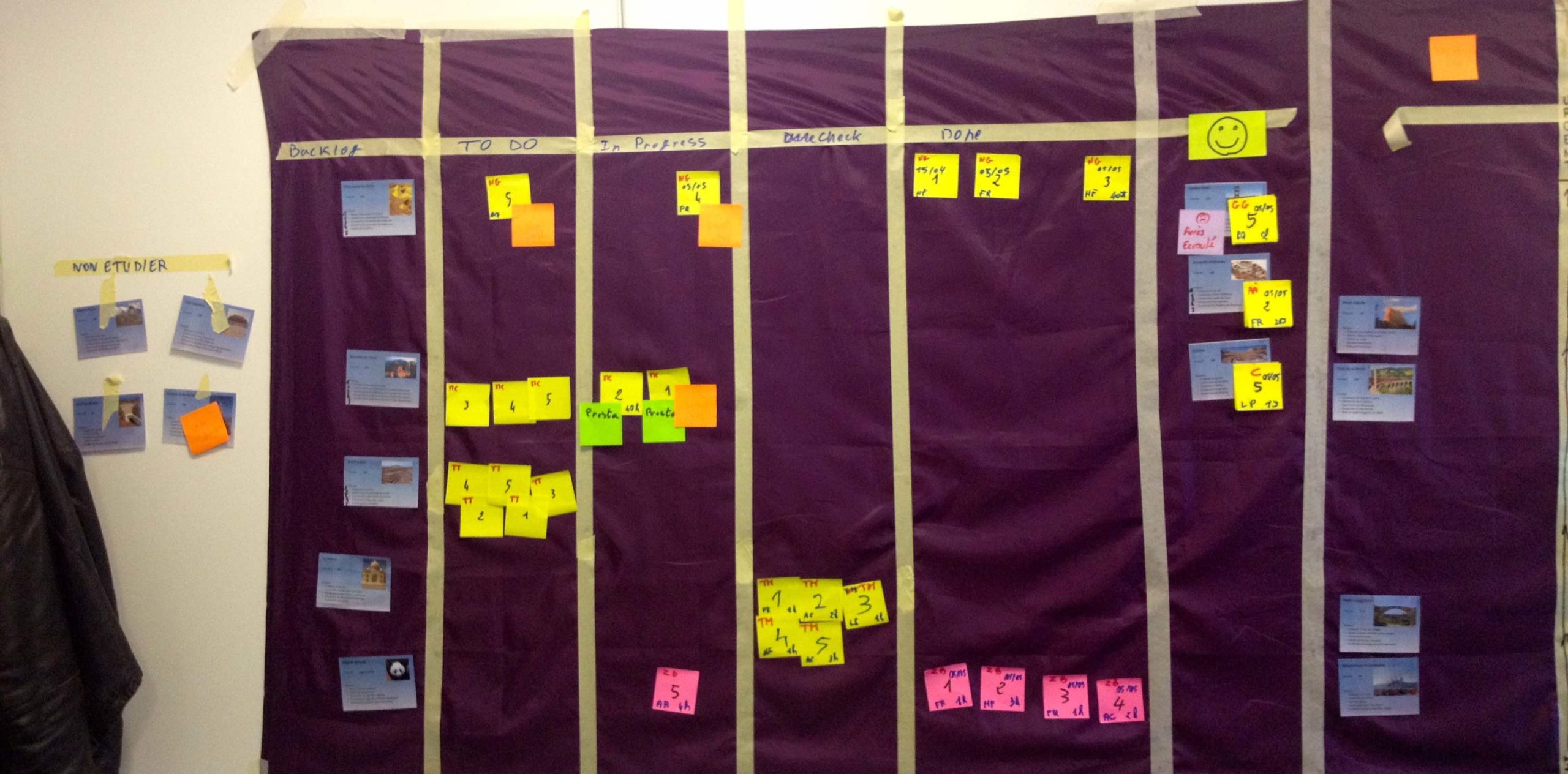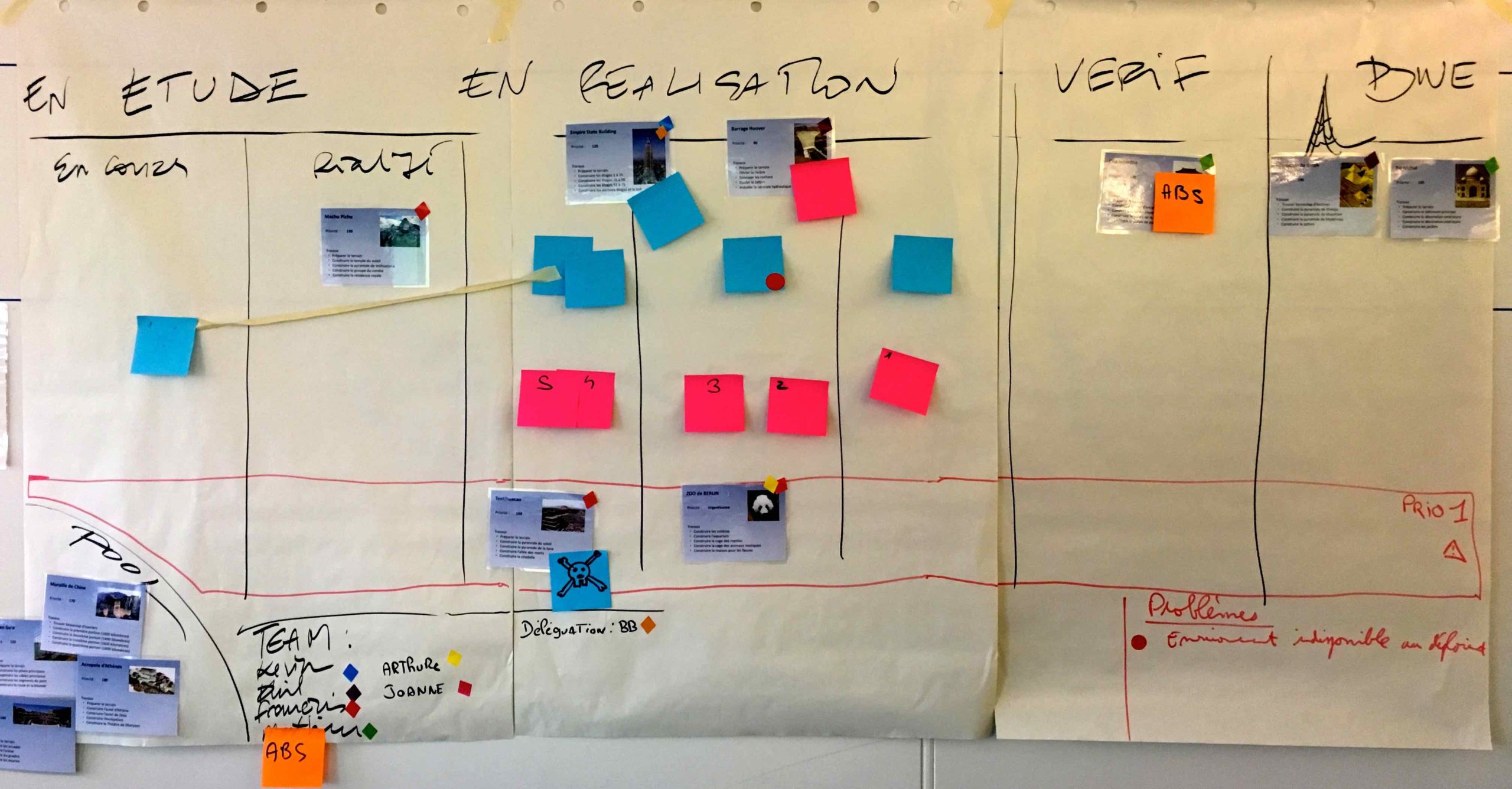Suite au kick-off d’accompagnement light (que j’avais décrit dans cet article), le module suivant rentre un petit peu plus en détails sur ce qu’est le Management Visuel. Pour ce faire, une combinaison théorie + pratique était de mise et il me paraît aujourd’hui difficile de passer à côté de l’excellent « Au Tableau », atelier d’Alexandre Boutin. Je me concentrerais donc sur cette partie pratique ici pour en décrire un déroulé type et les apprentissages que les participants peuvent en retirer.
Bonne lecture ! 🙂
Vous pouvez retrouver les instructions originales sur le blog d’Alexandre Boutin.
Matériel
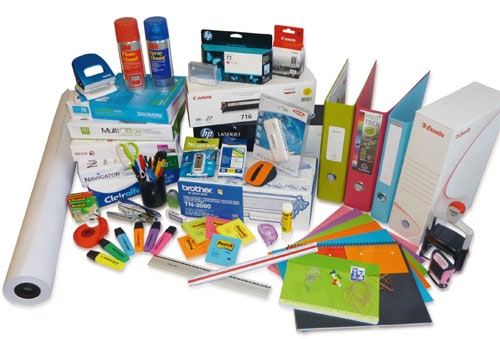
- Post-it de différentes couleurs, tailles, formes
- Feutres de couleurs
- Scotch de peintre, patafix
- Gommettes ou stickers variés
- Feuilles de paperboard
- Feuilles d’instructions pour les participants (prévoir plusieurs exemplaires par équipe)
- Set de 12 ouvrages par équipe
- Murs disponibles
Gardez à l’esprit que plus le matériel fourni sera varié, plus les participants auront la possibilité de laisser libre court à leur créativité ! Testez et vous jaugerez par vous-même ce qui vous paraît le plus important pour garantir un apprentissage de qualité pour les participants.
Moi qui dans mes premières animations n’amenais jamais de gommettes, elles sont presque devenues mes incontournables maintenant ! 😉
L’atelier
L’objectif de l’atelier est très simple : représenter visuellement des informations textuelles.
Pour ce faire, les participants vont évoluer dans 2 itérations comportant :
- une phase de production : où ils vont travailler à représenter visuellement les instructions qui leur auront été fournies
- une phase de revue : où ils prendront un moment pour échanger avec les autres équipes (et/ou l’animateur)
En terme de durée, pour que l’atelier tienne en une heure, j’effectue des itérations de 15′ (production) + 10′ (revue) avec donc une dizaine de minutes de slack pour gérer les impondérables et me donner un peu de flexibilité dans l’animation ! 🙂
Sinon, je trouve qu’une durée d’1h30 peut être pertinente pour obtenir des résultats plus aboutis et des échanges d’autant plus enrichissants.
Un déroulé
Malgré la simplicité de l’objectif, il arrive souvent que les participants soient biaisés par leurs connaissances Scrum ou Kanban et essaient à tout prix de reconstruire quelque chose qu’ils connaissent. Je m’assure donc à chaque fois de bien éclaircir au départ que l’objectif est simplement de reproduire visuellement les informations qui seront inscrites sur les feuilles d’instructions. 🙂
Après avoir distribué les feuilles d’instruction, je montre à l’ensemble des participants que tout le matériel est rassemblé au même endroit pour que chacun puisse venir se servir. J’insiste bien sur le fait que tout ce qui est disponible est fait pour être utilisé : en effet, j’ai réalisé que de donner des permissions pouvait radicalement changer les comportements en atelier, alors pourquoi s’en priver ? 😉
Partons sur une configuration d’atelier d’1h avec 2 équipes (3-6 personnes par équipe)
1ère itération : état d’avancement
La 1ère itération a pour optique de faire représenter aux participants la progression des différents ouvrages : on entend alors processus, granularité, état, allocation…
Production (15′)
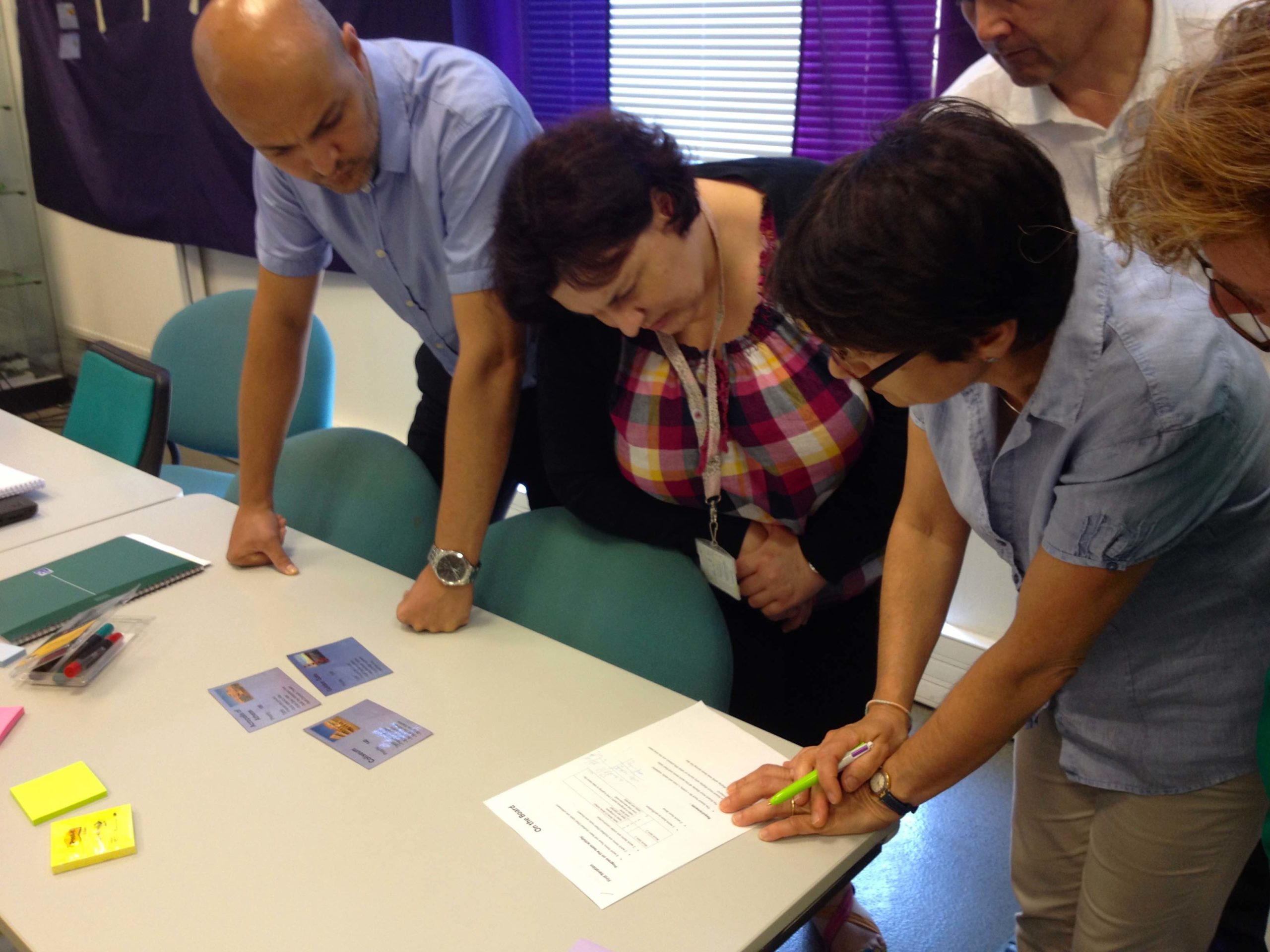
Typiquement, les participants se réunissent tous autour d’une table ou collent l’instruction au mur pour pouvoir découvrir ensemble le contenu.
Pour ma part, j’observe et écoute les différents groupes pour noter la manière dont ils construisent leur stratégie. Généralement, les groupes restent à réfléchir et à élaborer leur plans pendant un certain temps. Le rappel du temps restant les aide parfois à se mettre en mouvement : d’ailleurs je fais un rappel à 10′, 7′, 5′, 3′, 2′, 1′ en gros. 😛
Si un groupe n’a toujours pas bougé vers la moitié du temps, j’insiste sur le fait de faire un premier pas et d’afficher des éléments au mur pour commencer à voir les choses. Cela permet parfois aux groupes qui sont encore en désaccord sur des détails de mettre en place ce sur quoi ils sont déjà d’accord ! 😀
Maintenant, il m’est déjà arrivé d’avoir des groupes qui malgré les multiples relances, n’ont commencé à afficher des choses que vers les 3′ et n’ont donc pas eu grand chose à « montrer » pendant la revue. Même si cela est un apprentissage, je pense que c’est un cas à éviter au maximum car cela enlèverait du temps à la seconde itération pour rattraper, alors qu’elle a une optique différente.
Revue (10′)
Comme pour Top Chef, je demande à tout le monde de s’arrêter au temps imparti ! Chacun prend un peu de recul sur sa production et l’on se déplace vers l’une ou l’autre production. Chaque équipe aura donc un temps de 5′ pour partager et obtenir du feedback.
Pour aller à l’essentiel, je demande alors aux équipes d’expliquer la logique de leur production plutôt que d’expliquer le contenu (similaire aux 2 équipes).
En effet, on souhaite surtout savoir comment ils ont représenté les différents états des éléments, la double granularité (ouvrages et travaux), qui travaille sur quoi… plutôt que de savoir qu’un ouvrage a 2 travaux en cours et 1 terminé ! 😛
Je me permets également de structurer le feedback en posant ces 2 questions à l’autre équipe :
- Quelles sont les choses que vous trouvez bien dans cette production ?
- Quelles suggestions d’amélioration pourriez-vous proposer ?
Tout cela pour habituer les personnes à construire leurs feedbacks de manière positive et maximiser les feedbacks constructifs.
C’est lors de cette première revue que les équipes se rendent généralement compte que malgré des instructions similaires, les solutions peuvent parfois varier du tout au tout, la logique de la stratégie dépendant de l’équipe qui la met en place.
L’idée de la revue est donc non pas de faire un reporting sur ce qui a été fait, mais véritablement de partager la stratégie de chacune des équipes pour en retirer les bonnes idées et s’améliorer.
2nde itération : situations
La seconde itération comporte une mise à jour de la progression des éléments mais je demande généralement aux participants de se concentrer sur les exigences qui se trouvent à la fin. En effet, ce sont des situations habituelles pouvant être rencontrées dans les équipes et c’est pour moi là où l’on souhaite challenger les participants dans la représentation visuelle : on entend donc ici les urgences, absences, nouveaux arrivants, dépendances, problèmes…
Production (15′)
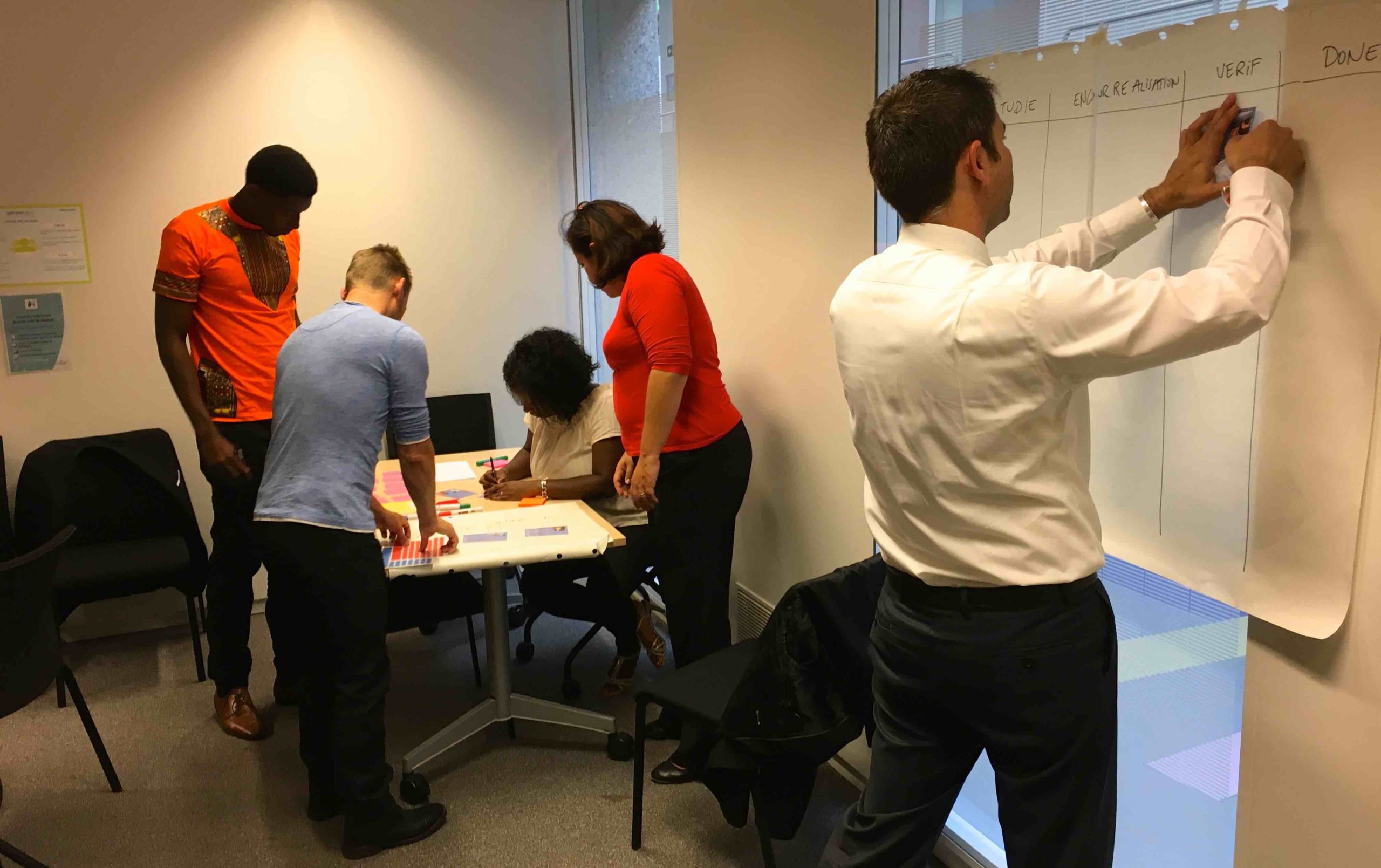
La seconde phase de production est généralement beaucoup plus dynamique dans le sens où chacun est reparti avec de nouvelles idées et avec un nouveau challenge.
La plupart de équipes continuent sur la base de ce qu’elles ont construit lors de la première itération : biais cognitif humain courant dans le sens où l’on n’aime pas jeter des choses sur lesquelles on a fourni de l’effort même si l’on sait que cela ne nous convient pas complètement. Maintenant, il est intéressant d’échanger avec les équipes qui font effectivement le choix de recommencer quelque chose suite à leurs apprentissages précédents.
On voit également apparaître de nouvelles « zones » sur le management visuel : une légende, des calendriers pour les absences, un listing des membres de l’équipe, un espace des points d’attention…
C’est typiquement ce que l’on souhaite partager dans cette 2nde itération : le management visuel ne se réduit pas à un simple tableau avec des colonnes indiquant la progression des éléments. Il nous est possible de matérialiser bien plus de choses permettant en un clin d’oeil d’avoir le maximum d’informations (pertinentes), encourageant alors une meilleure prise de décision car informée, collective et partagée.
Revue (10′)
La seconde revue se fait généralement plus facilement dans le sens où les participants connaissent déjà le processus.
On se focalise encore une fois sur la logique de chacune des productions et l’on partage sur la manière de représenter visuellement les différentes informations.
Je clôture généralement la 2nde revue en invitant chaque équipe à prendre un peu de recul sur leur production et en leur posant la question suivante :
Imaginez que votre manager vous demande un statut sur votre projet. En regardant votre management visuel, que pouvez-vous lui dire en quelques minutes ?
C’est là que les équipes se rendent compte de l’efficacité (ou non) de la structure de leur production. Arrivent-ils à trouver les informations pertinentes ? Est-ce suffisamment structuré pour ne pas nécessiter trop d’explications complémentaires ? Ont-ils une vision suffisamment haut niveau pour donner un statut en quelques minutes ? 🙂
Apprentissages
L’intérêt de l’expérimentation
Un petit peu comme pour le Marshmallow Challenge, c’est le souhait de vouloir trouver LA bonne solution du premier coup qui empêche les équipes de se mettre en mouvement au départ. Pourtant elles se rendent vite compte que c’est lorsqu’elles commencent à placer des choses sur le mur que la véritable collaboration commence. En effet, au départ lorsque les membres de l’équipe sont autour d’une table, les instructions ne sont pas dans le bon sens, il n’y a pas toujours la place pour chacun et donc l’engagement de l’ensemble n’est pas optimal. De plus, on a souvent des débats sur des solutions qui tant qu’elles ne sont pas mises en oeuvre, ne se basent que sur du ressenti personnel.
Expérimentez donc pour voir ensemble, apprendre ensemble et agir ensemble. 😉
Le management visuel, ce n’est pas si simple…
En continuité de l’expérimentation, on se rend vite compte que trouver un management visuel commun à une équipe n’est pas quelque chose d’évident.
Cela est d’ailleurs appuyé par le constat que chaque équipe obtient un résultat différent alors que les instructions sont exactement les mêmes. Il existe donc plein de bonnes pratiques mais l’important est de trouver celles qui correspondent localement à l’équipe qui va les utiliser.
On observe dans les différentes productions que pour la même information, différents moyens ont été utilisés pour la visualiser : des couleurs, des stickers, des espaces…
… mais ça doit rester simple !
Plus un management visuel est simple, plus il est flexible pour évoluer. On peut le voir entre les 2 itérations lorsque des équipes se contraignent par rapport à leur première conception alors que d’autres décident de repenser intégralement leur production. Il ne faut pas oublier que le management visuel est un outil d’équipe et donc pour que cet outil soit utilisé, il faut d’abord qu’il soit utile et utilisable ! Commencez petit, faites le évoluer comme ça s’il faut recommencer, le coût émotionnel sera probablement moins grand ! 😉
Des exemples de réalisation
Conclusion
Au Tableau est un atelier très riche permettant aux participants de découvrir la puissance du management visuel par la pratique. Il est assez simple à animer et je le trouve d’ailleurs plutôt agréable en termes de rythme et d’échanges avec les participants.
Je vous le recommande donc chaudement pour vos futurs ateliers (si ce n’est pas déjà fait!). Pour ma part, il fait déjà partie intégrante de mes formations Scrum / Kanban 🙂
Merci encore Alexandre pour ce partage !

